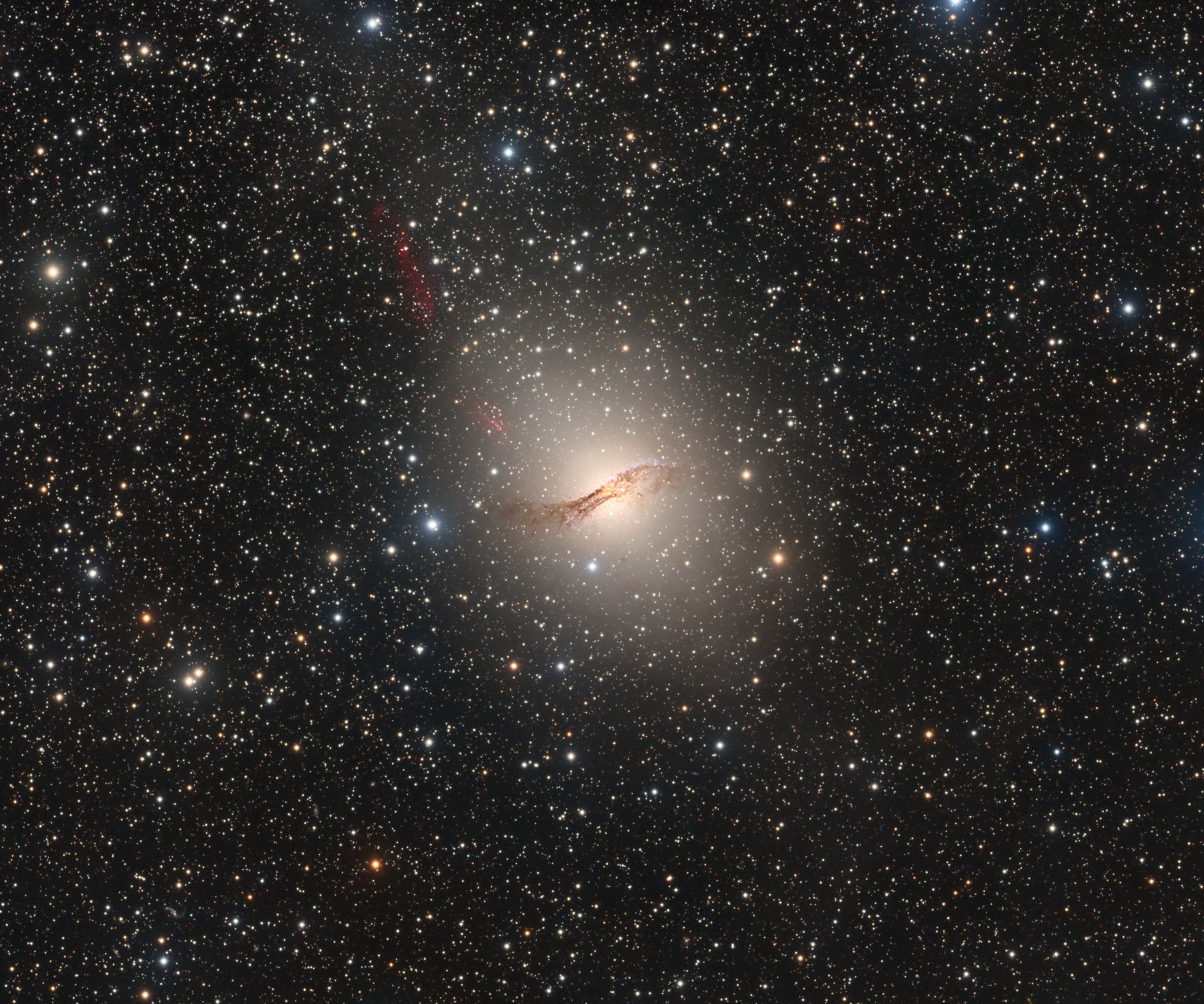Centaurus A (NGC 5128)

Click image for full size version
January 2, 2019
Centaurus A (NGC 5128; Cen A) is a showpiece galaxy in the southern constellation Centaurus, the Centaur. Cen A has a supermassive black hole at its centre that has 55 million times the mass of the Sun. The black hole emits jets that are responsible for X-ray and radio waves coming from the galaxy. These in turn energize hydrogen atoms to emit red light — the red linear structures emanating from the upper left of the galaxy in this image. Along the upper edge of the dark lane, particularly to the right, you can see blue star clusters and pink nebula that signify star formation in this active galactic nucleus. This is probably due to a long-ago collision between Cen A’s precurser — a large elliptical galaxy — and a smaller spiral galaxy. It’s not clear how far away Cen A lies, with estimates varying between 10-16 million light years. Many other galaxies are visible in this image, as shown by this annotated image.
Cen A lies in a region of sky that is not visible from my locale. This data was acquired remotely by Steve Mastellotto on Martin Pugh’s equipment in rural New South Wales, Australia. Steve preprocessed the data to make the master frames. I processed and combined the masters to make this image.
Tekkies:
Astro Physics 12″ Riccardi-Honders f3.8, SBIG STXL16200 with Astrodon LRGB Gen II and Ha – 5nm filters, Software Bisque Paramount ME. All pre-processing and processing in PixInsight 1. 8.6. Acquired from Martin Pugh’s Observatory in rural New South Wales, Australia, during June and July 2018.
24x15m L, R, G and B, and 10x30m Ha unbinned frames (total=21 hours).
Image scale for this camera/telescope combination is 1.07 arcsec/pixel.
Data Reduction and Cleanup
The BatchPreProcessing script was used to perform calibration, registration and integration of all frames. DynamicCrop was used to crop all the resulting masters identically. DynamicBackgroundExtraction was applied to each master twice with identical sample locations, first with division and then with subtraction.
RGB
Creation and cleanup: The R, G and B were combined to make an RGB image which was processed with PhotometricColorCalibration.
Linear Noise Reduction: MultiscaleLinearTransform was used to reduce noise in the RGB image. Layer settings for threshold and strength: Layer 1: 4.0 0.77 Layer 2: 3, 0.76 Layer 3: 2., 0.52 Layer 4: 1.5, 0.32.
Stretching: MaskedStretch was applied (Target background 0.12; Iterations 100, Clipping fraction 0.0001) to make a pleasing, bright image. CurvesTransformation was applied to boost contrast and brightness.
Luminance
Creation and cleanup of SynthL: The L, R, G and B masters were combined using ImageIntegration (average, additive with scaling, noise evaluation, iterative K-sigma / biweight midvariance, no pixel rejection).
Deconvolution: A star mask was made to use as a Local Deringing Support image. A copy of the image was stretched to use as a range mask. Deconvolution was applied (50 iterations, regularized Richardson-Lucy, external PSF made using the PSFImage script on a preview that included about 1/4 of the image).
Linear Noise Reduction: MultiscaleLinearTransform was used to reduce noise in the background areas, using an internal mask to protect bright structures. Layer settings for threshold and strength: Layer 1: 4.0 0.77 Layer 2: 3, 0.76 Layer 3: 2., 0.52 Layer 4: 1.5, 0.32, Layer 5: 1.5, 0.17.
Stretching: HistogramTransformation was applied to make a pleasing, bright image.
H-alpha
Deconvolution: A star mask was made to use as a Local Deringing Support image. A copy of the image was stretched to use as a range mask. Deconvolution was applied (50 iterations, regularized Richardson-Lucy, external PSF made using the PSFImage script).
Linear Noise Reduction: MultiscaleLinearTransform was used to reduce noise in the background areas of the Ha image. Layer settings for threshold and strength: Layer 1: 4.0 0.77 Layer 2: 3, 0.76 Layer 3: 2., 0.52 Layer 4: 1.5, 0.32.
Stretching: HistogramTransformation was applied to the Ha to make a pleasing, bright image.
Contrast Enhancement: HDRMultiscaleTransform was applied to the Ha twice, at scales of 6 and 4. A mask was used to select bright nebula and protect stars, faint nebula and background sky.
Combining SynthL, RGB and Ha
SynthLRGB: The SynthL was applied to the RGB image using LRGBCombine.
Nonlinear Noise Reduction: TGVDenoise was used in L*a*b* mode to reduce noise in the background and dim regions of the galaxy. SCNR was applied with Amount 0.33 using the same mask.
Contrast Enhancement: LocalHistogramEqualization was applied through a mask to the galaxy core, first with a scale of 50 (max contrast 1.5, strength 0.3, 1 iteration), followed by a scale of 144 (max contrast 1.5, strength 0.22, 1 iteration).
Saturation: The galaxy core mask was used to increase saturation in the core slightly. A luminance mask was used to increase saturation of highlights.
SynthLHaRGB: PixelMath was used to add Ha to the RGB, using a mask specifically targeted towards the red jets, with the following expressions for the R, G and B channels:
R: max($T[0], 1.65*Ha)
G: $T[1]
B: iif($T[0]<Ha, $T[2] + 0.07*Ha, $T[2])
The red channel of the resulting image was extracted with ChannelExtraction and the same mask used to reduce noise and sharpen the red structures. The result was used to replace the red channel in the original image.
Additional Processing
Sharpening: MultiscaleLinearTransform was used to sharpen Layers 2 and 3 (strengths of 0.16 and 0.18 respectively. A mask was used to protect dim regions of the galaxy, background and stars.
Final Steps: Background, galaxy core, galaxy halo, and star brightness, contrast and saturation were adjusted in several iterations using Curves with masks as required. The DarkStructureEnhance script was applied to a clone of the image with 8 layers and a strength of 0.20, and the result used to replace the galaxy core in the SynthLHaRGB image.






Nice one Ron! your version looks a bit different as the most ive seen, and thats a good thing! great job,keep up the good work and take care, Dan